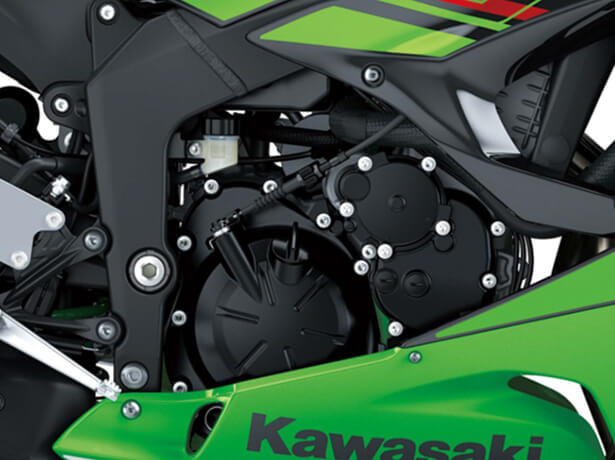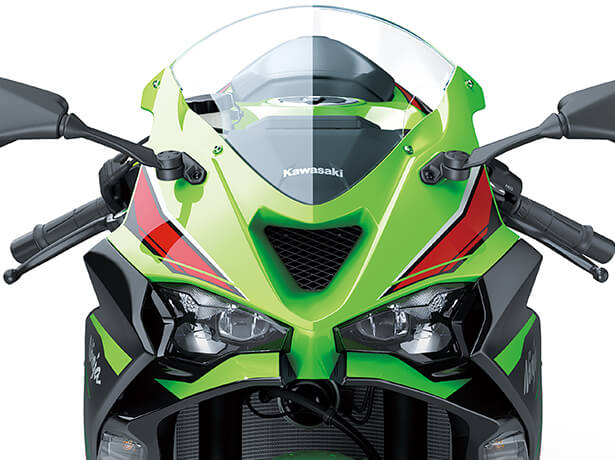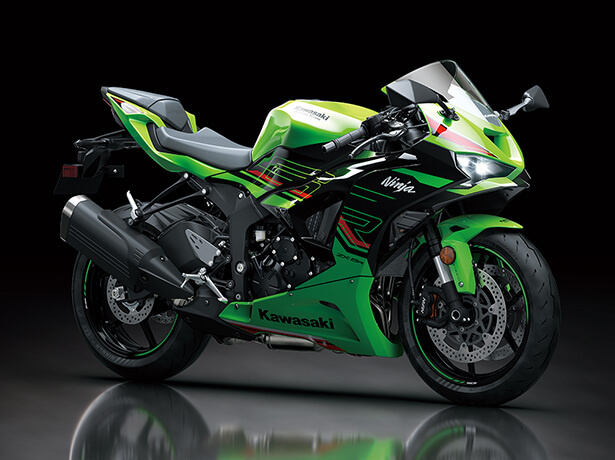
All-new styling for 2024 is inspired by the Ninja ZX-10R while embodying the ideal supersport image. While the Ninja ZX-10R’s functional beauty is—by necessity—performance-based, the new Ninja ZX-6R’s smooth, flowing design could focus on turning heads and capturing hearts. Compact new headlights and an intricately layered front cowl give the Ninja ZX-6R a new “face” that will serve as the template for future Ninja family models. Behind the sporty new windshield, the rider is greeted by full-colour TFT instrumentation with smartphone connectivity, integrated Riding Modes and other enhanced features that riders who live for corners and love cool supersport looks will welcome. Other updates include a change to round brake discs, which further contributes to the supersport image, and engine updates designed to meet emissions regulations.

The advantage offered by the Ninja ZX- 6R’s 37 cm3 greater displacement is significant for real world riding exhilaration. Greater performance across the rpm range is welcome when sport riding, both on back roads and on the racetrack. But stronger low and mid-range torque compared to “ordinary” mid-size supersport models also offers increased usability in everyday street-riding situations, like riding in stop-and-go city traffic or accelerating to pass another vehicle on the highway. Updates for 2024 include emissions-related adjustments.

All-new styling is inspired by the Ninja ZX-10R while embodying the ideal supersport image. New front and side cowls create a design that flows smoothly from head to tail. Compact new headlights and an intricately layered front cowl give the Ninja ZX-6R its new “face,” while blacked out engine covers and silencer add to the supersport image and LED turn signals complete an all-LED lighting package.

The new 4.3” all-digital TFT colour instrumentation gives the cockpit a high-tech, high-grade appearance. The new meter also offers additional features unavailable on the previous model.

All-inclusive modes that link KTRC and Power Mode allow riders to easily set traction control and power delivery to suit a given riding situation. Riders can choose from three settings (Sport, Road, Rain) or a manual setting (Rider). In the manual Rider mode, each of the systems can be set independently.
- Sport: enables riders to enjoy sporty riding.
- Road: covers a wide range of situations, from city riding to highway cruising and rural roads.
- Rain: offers rider reassurance when riding on a wet road surface.
Bluetooth technology built into the instrument panel enables riders to connect to their bike wirelessly. Using the smartphone application “RIDEOLOGY THE APP,” a number of instrument functions can be accessed, contributing to an enhanced motorcycling experience.
A number of functions are available:
- Vehicle Info: information such as fuel gauge, odometer, distance (odometer)-based maintenance reminder, etc can be viewed via the smartphone.
- Riding Log: GPS route information as well as vehicle running information can be logged and viewed via the smartphone.
- Telephone notices: when a call or mail is received by the smartphone, this is indicated on the instrument display.
Tuning – General Settings: general instrument display settings (such as preferred units, time, 12h/24h format, etc) can be adjusted via the smartphone.

- KTRC (Kawasaki TRaction Control)
Three modes cover a wide range of riding conditions, offering either enhanced sport riding performance or the peace of mind under certain conditions to negotiate low-traction surfaces with confidence.
- Power Mode Selection
Riders can choose from Full Power or Low Power mode.
- KIBS (Kawasaki Intelligent anti-lock Brake System)
Kawasaki’s supersport-grade high-precision brake management system, designed to take into account the particular handling characteristics of supersport motorcycles, ensures highly efficient braking with minimal intrusion during sport riding.
- KQS (Kawasaki Quick Shifter)
Standard-equipment quick shifter allows clutchless upshifts, adding to sport riding fun.
| DIMENSIONS | |
|---|---|
| Overall length | 2,025 mm |
| Overall width | 710 mm |
| Overall height | 1,105 mm |
| Wheelbase | 1,400 mm |
| Road clearance | 130 mm |
| Seat height | 830 mm |
| Curb mass | 198 kg |
| Dry mass | - |
| Fuel tank capacity | 17 litres |
| PERFORMANCE | |
|---|---|
| Max. power | 91.0 kW {124 PS} / 13,000 min-1 |
| Max. Power with Ram Air | 95.2 kW {129PS} / 13,000 min-1 |
| Max. torque | 69.0 N·m {7.0 kgƒ·m} / 10,800 min-1 |
| ENGINE | |
|---|---|
| Type / Valve system | 4-stroke In-Line Four |
| Coolant System | Liquid-cooled |
| Bore x Stroke | 67.0 x 45.1 mm |
| Displacement | 636 cm3 |
| Compression ratio | 12.9:1 |
| Fuel supply | Fuel injection: ø38 mm x 4 with oval sub-throttles |
| Lubrication system | Forced Lub. Wet |
| Starting system | EL. Starter |
| Ignition system | Digital |
| DRIVETRAIN | |
|---|---|
| Driving system | Chain |
| Transmission | 6-speed, return |
| Primary reduction ratio | 1.900 (76/40) |
| 1st Gear ratios | 2.846 (37/13) |
| 2st Gear ratios | 2.200 (33/15) |
| 3st Gear ratios | 1.850 (37/20) |
| 4st Gear ratios | 1.600 (32/20) |
| 5st Gear ratios | 1.421 (27/19) |
| 6st Gear ratios | 1.300 (26/20) |
| Final reduction ratio | 2.867 (43/15) |
| Clutch type (Primary) | Wet, multi-disc |
| FRAME | |
|---|---|
| Type | Tubular, Diamond |
| Front Suspension | ø41 inverted fork (SFF-BP) with rebound and compression damping and spring preload adjustability, and top-out springs |
| Rear Suspension | Bottom-Link Uni Trak, gas-charged shock with piggyback reservoir, compression and rebound damping and spring preload adjustability |
| Front Wheel travel | 120 mm |
| Rear Wheel travel | 151 mm |
| Caster (Rake angle) | 23.5° |
| Trail | 101 mm |
| Steering angle (left/right) | 27° / 27° |
| Front Tyre | 120/70ZR17M/C (58W) |
| Rear Tyre | 180/55ZR17M/C (73W) |
| Front Type Brake | Dual semi-floating ø310 mm discs |
| Caliper (Front) | Caliper- Dual radial-mount, monobloc, opposed 4-piston |
| Rear Type Brake | Single ø220 mm disc |
| Caliper (Rear) | Caliper- Single-bore pin-slide |